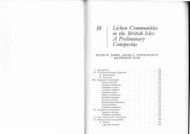You also want an ePaper? Increase the reach of your titles
YUMPU automatically turns print PDFs into web optimized ePapers that Google loves.
44* Thallus not typically sorediate 45<br />
45 Thallus white-yellow to yellow, usually pruinose,<br />
with very uneven upper surface <strong>of</strong> convex to<br />
almost spherical or even flattened, ± attached<br />
areoles/granules, thick to very thick. Ap. brownorange,<br />
at first concave, then flat, with yellow,<br />
<strong>of</strong>ten pruinose proper margin and swollen,<br />
permanent, ca 0.2 mm thick pruinose thalloid<br />
margin, -1.5 mm. Sp. 10-15 x 6-8 µm. On walls<br />
. C. ruderum<br />
45* Thallus (orange)yellow to ochre-yellow, not<br />
pruinose, areolate, areoles -1 mm, thick, <strong>of</strong><br />
granules to elongate narrow cushions <strong>of</strong> (40)50-<br />
100 µm diameter, moderate to very thick. Ap.<br />
orange to orange-red, soon moderately convex,<br />
with depressed, usually soon regressing,<br />
commonly same-colored, nonpruinose proper<br />
margin, <strong>of</strong>ten covered on the outer side with<br />
thallus granules, -0.6(0.9) mm . C. coronata<br />
46 On silicate rock 47<br />
46* On lime-rich rock, mortar, concrete 51<br />
47 Thallus gray-rose to (yellowish)cinnabar red,<br />
small, -1.5 cm, cracked areolate, areoles<br />
conspicuously flat, smooth, usually somewhat<br />
enlarged at the thallus margin, -1.5 mm. Ap.<br />
carmine-red, at first punctiform, then flat, usually<br />
angular, indefinitely margined, -0.4 mm. Sp. 7-<br />
11 x 4-6 µm C. rubelliana<br />
47* Thallus not gray-rose to cinnabar red . 48<br />
48 Septum thin, -2(3) µm. Sp. 12-23 x 5-7.5 µm.<br />
Thallus thin, areolate to indefinite, citron-yellow,<br />
yellow, yellow-gray. Areoles flat to somewhat<br />
raised and there lighter at the margin. Ap. -0.6(1)<br />
mm, <strong>of</strong>ten crowded into groups. Disk orangeyellow<br />
to ochre, flat, with permanent, entirely<br />
yellow margin and <strong>of</strong>ten with outer layer<br />
depressed, sometimes granular thallus “collar”.<br />
Relation to C. ferrarii (Bagl.) Jatta yet unclear<br />
. ! C. crenulatella<br />
48* Septum thicker . 49<br />
49 Ap. yellow to olive-yellow, flat to convex, <strong>of</strong>ten<br />
with lighter margin, -0.5 mm. Thallus light<br />
yellow, yellow, citron-yellow, thin, smoothed,<br />
coherent to fleckwise developed. Sp. 9-15 x 4.5-<br />
7.5 µm C. vitellinula*<br />
49* Ap. disk orange, orange- to rust brown . 50<br />
50 Thallus orange yellow to yellow-brown, areolate<br />
to almost lumpy, areoles ± angular, usually 0.2-<br />
0.4 mm. Ap. orange to red-orange, with<br />
depressed, finally indefinite, same-colored proper<br />
margin, -0.3(0.5) mm. Sp. 9-15 x 4.5-8 µm.<br />
Septum ¼-1/2 <strong>of</strong> the sp. length<br />
. C. irrubescens<br />
50* Thallus citron-, green- to gray-yellow, ochre, pale<br />
yellow-(whitish), weakly cracked to usually<br />
cracked-areolate, areoles flat to concave, <strong>of</strong>ten<br />
grazed by snails. Ap. brown- orange to rustbrown<br />
(color clearly contrasting from the thallus,<br />
thereby the thallus ± two colored), with usually<br />
somewhat lighter, orange colored proper margin,<br />
sometimes with outer layered thallus margin,<br />
which thins out very soon and only remains<br />
recognizable only in section, -1(1.3) mm. Sp. 12-<br />
19 x 7-10(11) µm. Septum 1/3 - 1/2 <strong>of</strong> the sp.<br />
length C. flavovirescens<br />
51 Ripe sp. 4-celled, 11-19 x 5-8 µm (Sp. ).<br />
Thallus light yellow, light ochre, white-gray with<br />
yellowish flecks, smooth to finely cracked, thin.<br />
Ap. yellow- to brown-orange, with yellow/orange<br />
proper margin, at first concave, then flat, -0.7 mm<br />
C. ochracea<br />
51* Sp. 2-celled 52<br />
52 Septum very thin. <strong>Lichens</strong> usually on mortar .<br />
C. crenulatella (48)<br />
52* Septum thicker, ¼-1/2 the sp. length . 53<br />
53 Thallus green-yellow, citron yellow, gray-yellow<br />
to pale yellowish, <strong>of</strong>ten grazed upon and whitish<br />
in places, weakly cracked to cracked-areolate<br />
(areolate-squamulose), with the ap. becoming<br />
“two colored.” Ap. -1.5 mm, orange-brown, with<br />
usually lighter, orange colored proper margin and<br />
sometimes outer layer <strong>of</strong> the thalloid margin,<br />
sitting up. Sp. 12-19 x 7-10(11) µm. (Hyp. in<br />
the region commonly not/scarcely inspersed).<br />
Only on the upper surface <strong>of</strong> leached limestone<br />
C. flavovirescens<br />
53* Thallus usually deep yellow to orange, even<br />
ochre-yellow, very variable, coherent to cracked<br />
areolate or almost squamulose, sometimes even<br />
reduced, not becoming two-colored. Ap. -1mm,<br />
usually orange, margin <strong>of</strong>ten somewhat lighter<br />
than the disk, but commonly not clearly other<br />
colored, soon convex and marginless. Sp. 10-16<br />
x 6-9(10) µm. (Hyp. not or ± inspersed). (C.<br />
dolomiticola s.l.) . 54<br />
54 Living on endolithic Verrucaria species, small, -<br />
1.5 cm . 10<br />
54* Not on endolithic Verrucaria species . 55<br />
55 Parasitic on epilithic crustose lichens, e.g.<br />
Acarospora species. Thallus areolate, almost<br />
small squamulose, with ca. 0.5 mm large,<br />
scattered or in several groups or areoles. Ap. -<br />
1.5(2) mm . C. inconnexa (9)<br />
55* Commonly not parasitising other lichens.<br />
Thallus cracked areolate to mostly areolate, thick<br />
to thin and disappearing, even granular. Areoles<br />
0.2-2 mm with uneven upper surface, <strong>of</strong>ten<br />
grazed upon. Ap. -1(1.5) mm, sessile to sunken.<br />
Very variable species. Ap. size and thallus<br />
condition very distinctive . ! C. dolomiticola<br />
Ecology and Distribution <strong>of</strong> the Species<br />
Caloplaca albolutescens (Nyl.) Oliv.<br />
Like C. teicholyta (↑), but predominantly on<br />
sandstone, scarcely on mortar – mieur-med – rare<br />
(3); Ne, Rh, süSch, Hü<br />
132





